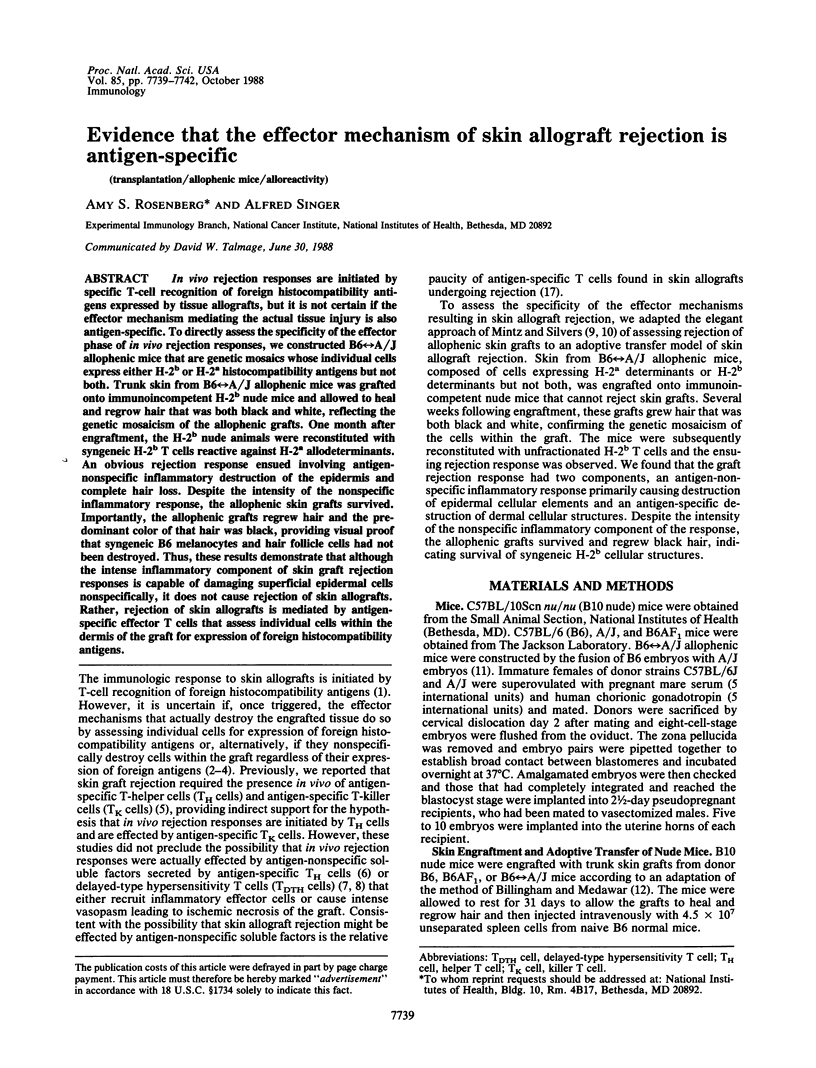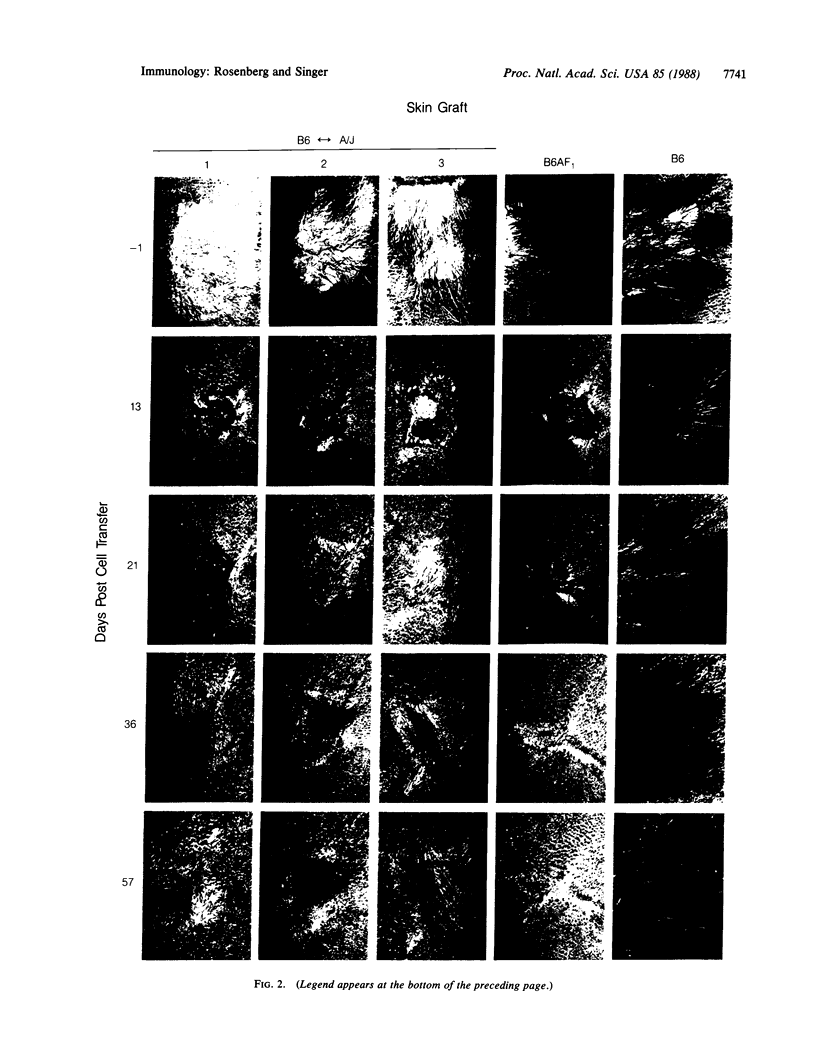Abstract
In vivo rejection responses are initiated by specific T-cell recognition of foreign histocompatibility antigens expressed by tissue allografts, but it is not certain if the effector mechanism mediating the actual tissue injury is also antigen-specific. To directly assess the specificity of the effector phase of in vivo rejection responses, we constructed B6 in equilibrium with A/J allophenic mice that are genetic mosaics whose individual cells express either H-2b or H-2a histocompatibility antigens but not both. Trunk skin from B6 in equilibrium with A/J allophenic mice was grafted onto immunoincompetent H-2b nude mice and allowed to heal and regrow hair that was both black and white, reflecting the genetic mosaicism of the allophenic grafts. One month after engraftment, the H-2b nude animals were reconstituted with syngeneic H-2b T cells reactive against H-2a allodeterminants. An obvious rejection response ensued involving antigen-nonspecific inflammatory destruction of the epidermis and complete hair loss. Despite the intensity of the nonspecific inflammatory response, the allophenic skin grafts survived. Importantly, the allophenic grafts regrew hair and the predominant color of that hair was black, providing visual proof that syngeneic B6 melanocytes and hair follicle cells had not been destroyed. Thus, these results demonstrate that although the intense inflammatory component of skin graft rejection responses is capable of damaging superficial epidermal cells nonspecifically, it does not cause rejection of skin allografts. Rather, rejection of skin allografts is mediated by antigen-specific effector T cells that assess individual cells within the dermis of the graft for expression of foreign histocompatibility antigens.
Full text
PDF



Images in this article
Selected References
These references are in PubMed. This may not be the complete list of references from this article.
- Billingham R. E., Silvers W. K. Studies on the migratory behavior of melanocytes in guinea pig skin. J Exp Med. 1970 Jan 1;131(1):101–117. doi: 10.1084/jem.131.1.101. [DOI] [PMC free article] [PubMed] [Google Scholar]
- KLEIN E., KLEIN G. Detection of an allelic difference at a single gene locus in a small fraction of a large tumour-cell population. Nature. 1956 Dec 22;178(4547):1389–1391. doi: 10.1038/1781389a0. [DOI] [PubMed] [Google Scholar]
- Lafferty K. J., Prowse S. J., Simeonovic C. J., Warren H. S. Immunobiology of tissue transplantation: a return to the passenger leukocyte concept. Annu Rev Immunol. 1983;1:143–173. doi: 10.1146/annurev.iy.01.040183.001043. [DOI] [PubMed] [Google Scholar]
- Loveland B. E., Hogarth P. M., Ceredig R., McKenzie I. F. Cells mediating graft rejection in the mouse. I. Lyt-1 cells mediate skin graft rejection. J Exp Med. 1981 May 1;153(5):1044–1057. doi: 10.1084/jem.153.5.1044. [DOI] [PMC free article] [PubMed] [Google Scholar]
- Mason D. W., Dallman M. J., Arthur R. P., Morris P. J. Mechanisms of allograft rejection: the roles of cytotoxic T-cells and delayed-type hypersensitivity. Immunol Rev. 1984;77:167–184. doi: 10.1111/j.1600-065x.1984.tb00721.x. [DOI] [PubMed] [Google Scholar]
- Mason D. W., Morris P. J. Effector mechanisms in allograft rejection. Annu Rev Immunol. 1986;4:119–145. doi: 10.1146/annurev.iy.04.040186.001003. [DOI] [PubMed] [Google Scholar]
- Mintz B., Silvers W. K. "Intrinsic" immunological tolerance in allophenic mice. Science. 1967 Dec 15;158(3807):1484–1486. doi: 10.1126/science.158.3807.1484. [DOI] [PubMed] [Google Scholar]
- Mintz B., Silvers W. K. Histocompatibility antigens on melanoblasts and hair follicle cells. Cell-localized homograft rejection in allophenic skin grafts. Transplantation. 1970 May;9(5):497–505. doi: 10.1097/00007890-197005000-00009. [DOI] [PubMed] [Google Scholar]
- Rosenberg A. S., Mizuochi T., Sharrow S. O., Singer A. Phenotype, specificity, and function of T cell subsets and T cell interactions involved in skin allograft rejection. J Exp Med. 1987 May 1;165(5):1296–1315. doi: 10.1084/jem.165.5.1296. [DOI] [PMC free article] [PubMed] [Google Scholar]
- Snider M. E., Steinmuller D. Nonspecific tissue destruction as a consequence of cytotoxic T lymphocyte interaction with antigen-specific target cells. Transplant Proc. 1987 Feb;19(1 Pt 1):421–423. [PubMed] [Google Scholar]
- Steinmuller D., Tyler J. D., Snider M. E., Noble R. L., Riser B. L., Maassab H. F., Galli S. J. Tissue destruction resulting from the interaction of cytotoxic T cells and their targets. Ann N Y Acad Sci. 1988;532:106–118. doi: 10.1111/j.1749-6632.1988.tb36330.x. [DOI] [PubMed] [Google Scholar]
- Steinmuller D. Which T cells mediate allograft rejection? Transplantation. 1985 Sep;40(3):229–233. doi: 10.1097/00007890-198509000-00001. [DOI] [PubMed] [Google Scholar]



